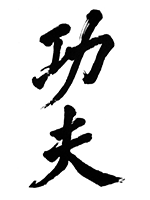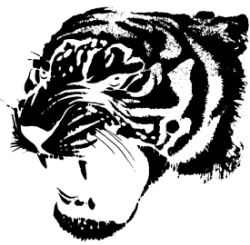 Legends claim that Chinese martial arts originated over 4,000 years ago during the Xia Dynasty, introduced by the Yellow Emperor Huangdi circa 2698 BCE, but Kung Fu as we know it today developed through the institutionalization of the Shaolin monks many years later. The first Shaolin temple was built at Song Shan in Honan, China, by Emperor Hsiao-wen in 496 CE, on a hill surrounded by young forest (“Shaolin” derives from the Mandarin dialect “shao lin” which translates to “young forest”). The first abbot, Tamo, brought martial arts into the monks’ daily routine as a way to stay healthy and fit, and for protection against wild animals and other dangers of life in the Chinese countryside.
Legends claim that Chinese martial arts originated over 4,000 years ago during the Xia Dynasty, introduced by the Yellow Emperor Huangdi circa 2698 BCE, but Kung Fu as we know it today developed through the institutionalization of the Shaolin monks many years later. The first Shaolin temple was built at Song Shan in Honan, China, by Emperor Hsiao-wen in 496 CE, on a hill surrounded by young forest (“Shaolin” derives from the Mandarin dialect “shao lin” which translates to “young forest”). The first abbot, Tamo, brought martial arts into the monks’ daily routine as a way to stay healthy and fit, and for protection against wild animals and other dangers of life in the Chinese countryside.Later, around 610, the third abbot of the temple at Honan increased martial training for the monks, including weapons training (purely for self-defense), and the long evolution of various styles of Kung Fu began as monks were encouraged to develop new skills. Surrounded by the vastness and variety of nature, styles evolved in imitation of nature, following the graceful movements of the crane, the deadly strikes of the snake and the tiger, and the unrelenting grip of the eagle’s claw.
Over hundreds of years, from the 7th century to the 21st, every technique and theory of Kung Fu has been broken down, refined, studied and practiced, developing into many different styles in various regions of China, and ultimately forming the basis of many other forms of martial arts in other regions of the world, but the basic movements and techniques of Kung Fu originally taught and studied at the Shaolin temples still remain the foundation of Kung Fu training. These foundational techniques can be grouped into two different broad areas of training: the internal and the external methods. The internal method focused on staying relaxed and the creation of energy. The external method focused on physical speed and muscular strength. These two methods of training work together to make Kung Fu a complete martial arts system.
“It was not the intent of nature study to emulate the animals in gung fu practice, because the practitioner would remain a human. Rather, it was intended that principles and movements could be imitated to the advantage of the human martial artist.” — Order of Shaolin Ch’an, The Shaolin Grandmasters’ Text
Upcoming Kung Fu Classes
- July 27, 2024
- 11:00 am
- July 27, 2024
- 12:30 pm
- July 29, 2024
- 11:00 am
Kung Fu: Black Belts >
Kung Fu: Color Belts >
Kung Fu: All Levels >
Ying Jow Pai (Eagle Claw)
 The origins of Ying Jow Pai reach back as far as the 12th century during the Southern Sung Dynasty in China. During this time, the Sung army was led by General Ngok Fei who was very successful in repelling Mongolian invaders using fighting techniques called Ying Kuen. Ngok Fei developed this system by adapting techniques he learned from a monk named Jow Tong in the Sil Lum monastery. Ngok’s reputation for success in battle helped to spread the system throughout northern China where it became known as Ying Sao (Eagle Hand) or “108 Locking Hand Techniques”. Ying Sao consisted largely of blocking, punching, grappling locking and pressure point strikes. Eventually the system found its way back to the Sil Lum monastery, where it continued to be taught, essentially unaltered for almost 400 hundred years.
At some point during the Ming Dynasty (1368-1544 CE), a monk at the Sil Lum monastery named Lai Chin combined the 108 Locking Hand Techniques with the high kicks and intricate footwork of another existing Kung Fu system called Faan Tzi. The result was the Ying Jow Pai (Northern Eagle Claw) system that is still taught today. Over the next four and half centuries, Ying Jow Pai would continue gain recognition even during times when the political environment demanded practice in secrecy, as during parts of the Ching Dynasty (1644-1911) and continued to be handed down from teacher to student in unbroken lineage. By 1915, through one of the most famous Eagle Claw masters – Chan Tzi Ching – Ying Jow Pai was introduced to southern China and taught in open (non-monastic) schools such as the Ching Mo Association gymnasium in Shanghai, and a second such school opened later in Hong Kong. One of his students, Lau Fat Mon, would continue to spread Ying Jow Pai throughout southern China, teaching until his passing in 1964. This tradition was continued by Lau Fat Mon’s students, including Ng Wai Nung, and Ng’s student, the current Grandmaster Leung Shum. Grandmaster Leung Shum brought the Eagle Claw system to America in 1971, and opened his Ying Jow Pai School in New York City in 1973. Since that time, Grandmaster Shum has passed the Eagle Claw legacy on to thousands of students, and his students’ students. Sifu David Slaughter is honored to be a part of this Ying Jow Pai lineage and legacy.
The origins of Ying Jow Pai reach back as far as the 12th century during the Southern Sung Dynasty in China. During this time, the Sung army was led by General Ngok Fei who was very successful in repelling Mongolian invaders using fighting techniques called Ying Kuen. Ngok Fei developed this system by adapting techniques he learned from a monk named Jow Tong in the Sil Lum monastery. Ngok’s reputation for success in battle helped to spread the system throughout northern China where it became known as Ying Sao (Eagle Hand) or “108 Locking Hand Techniques”. Ying Sao consisted largely of blocking, punching, grappling locking and pressure point strikes. Eventually the system found its way back to the Sil Lum monastery, where it continued to be taught, essentially unaltered for almost 400 hundred years.
At some point during the Ming Dynasty (1368-1544 CE), a monk at the Sil Lum monastery named Lai Chin combined the 108 Locking Hand Techniques with the high kicks and intricate footwork of another existing Kung Fu system called Faan Tzi. The result was the Ying Jow Pai (Northern Eagle Claw) system that is still taught today. Over the next four and half centuries, Ying Jow Pai would continue gain recognition even during times when the political environment demanded practice in secrecy, as during parts of the Ching Dynasty (1644-1911) and continued to be handed down from teacher to student in unbroken lineage. By 1915, through one of the most famous Eagle Claw masters – Chan Tzi Ching – Ying Jow Pai was introduced to southern China and taught in open (non-monastic) schools such as the Ching Mo Association gymnasium in Shanghai, and a second such school opened later in Hong Kong. One of his students, Lau Fat Mon, would continue to spread Ying Jow Pai throughout southern China, teaching until his passing in 1964. This tradition was continued by Lau Fat Mon’s students, including Ng Wai Nung, and Ng’s student, the current Grandmaster Leung Shum. Grandmaster Leung Shum brought the Eagle Claw system to America in 1971, and opened his Ying Jow Pai School in New York City in 1973. Since that time, Grandmaster Shum has passed the Eagle Claw legacy on to thousands of students, and his students’ students. Sifu David Slaughter is honored to be a part of this Ying Jow Pai lineage and legacy.Pai Lum And The Five Animal Styles
“Pai Lum is not a technique, it is a way of doing technique.” — Pai Li Lung (adopted grandson of late Grandmaster Daniel K. Pai)
Pai Lum (White Dragon Fist) is based upon the five animal styles of Kung Fu. Pai Lum was originally developed by Pai Yuefeng (later known by his Buddhist name Chiuyue) and the monks of the Shaolin temple as an integrated system through which to practice the techniques of all five animal styles. This system passed from generation to generation within the Pai family under various names, making its way from China to Hawaii, and finally to the mainland U.S. in the late 1950’s with the arrival the late Grandmaster Danial Kane Pai. To understand Pai Lum one must first appreciate its foundation, the five animal styles:

Crane
The crane styles trace their origins to Tibet, with variations developed by the Shaolin order in China. These styles imitate the agility and speed of the crane, the large water-wading bird whose slender, fragile appearance belies ts formidable fighting skill. Crane styles utilize complex footwork, with precision striking techniques, and are generally considered long-range styles. Martial artists learn grace and precision, as well as location of human body pressure points, from these difficult to master styles.

Tiger
The many diverse tiger styles originate from various regions within China, and have subsequently infused their techniques into martial arts systems in many other parts of the world, including Malaysia, Myanmar, Thailand and the Philippines. Tiger styles focus on physical strength, and are characterized by their powerful kicks, strikes and clawing motions. Firm stances ground the martial artist for the ability to strike from almost any position. Unlike other styles such as Crane or Dragon, there is little subtlety in Tiger forms.

Snake
Although snake techniques have been incorporated into a host of martial arts systems, very little is known of their origin prior to incorporation as foundation sets in traditional Shaolin and Chinese family styles. Some believe that snake styles were among the first systematic martial arts styles because they demonstrate ancient knowledge of human body vital spots along the ch’i meridians. Snake styles are easy to recognize from the pin-point strikes to these vital spots and twisting arm movements used to disguise the line of attack. Snake practitioners wait patiently for the opportunity to strike with precision. They attack rapidly, springing from a resting position, using supple movements for evasion, and using rhythmic repeated strikes to vital spots.

Leopard
The leopard style is characterized by the “leopard’s paw” fist and by very low stances that are constantly moving. Practitioners of the leopard style wait for an opening and then strike at secondary vital points. Once in motion, the leopard practitioner lets loose a barrage of strikes, aiming at lower body targets such as the solar plexus, abdomen and groin.

Dragon
The mythological dragon (generally a composite of lion, monitor lizard, python and Chinese alligator) has been much revered throughout Chinese history, with the five-clawed dragon a symbol of Chinse royalty. Dragon-like movements were part of Shaolin practice as early as 680 CE, but competing legends suggest other origins of the first defined style: one attributes the first dragon style to Shaolin priestess Ng Mui and the other to Shaolin monk Mui Fa San Yang, both around mid-sixteenth century CE. Eventually two distinct styles evolved: Southern (1565) and Northern (1680), which then further evolved into many family styles. Dragon style movements are long, flowing and continuous, designed to develop alertness and concentration. Dragon practitioners sense and respond to an opponent’s movements effortlessly to redirect the opponent, rather than resist, a technique sometimes described as “riding the wind” or “merging with the opponent”. The dragon’s key defense is evasion by rotating the upper or lower body without altering the stance, and allowing the opponent to tire.
